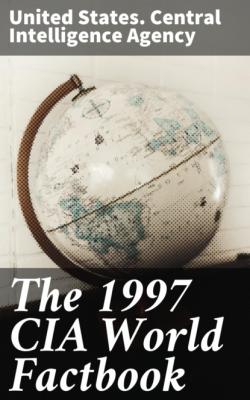The 1997 CIA World Factbook. United States. Central Intelligence Agency
Чтение книги онлайн.
Читать онлайн книгу The 1997 CIA World Factbook - United States. Central Intelligence Agency страница 20
 organization participation: CE, ECE, ICRM, IFRCS,
organization participation: CE, ECE, ICRM, IFRCS,Interpol, IOC, ITU, UN, UNESCO, WIPO, WToO
Diplomatic representation in the US: chief of mission : Ambassador Juli MINOVES-TRIQUELL (also Permanent Representative to the UN) chancery: 2 United Nations Plaza, 25th Floor, New York, NY 10017 telephone: [1] (212) 750–8064 FAX: [1] (212) 750–6630
Diplomatic representation from the US: the US does not have an embassy in Andorra; US interests in Andorra are represented by the Consulate General's office in Barcelona (Spain); mailing address: Paseo Reina Elisenda, 23, 08034 Barcelona, Spain; telephone: (343) 280–2227; FAX: (343) 205–7705; note - Consul General Maurice S. PARKER makes periodic visits to Andorra
Flag description: three equal vertical bands of blue (hoist side), yellow, and red with the national coat of arms centered in the yellow band; the coat of arms features a quartered shield; similar to the flags of Chad and Romania that do not have a national coat of arms in the center
Economy
Economy - overview: Tourism, the mainstay of Andorra's tiny, well-to-do economy, accounts for roughly 80% of GDP. An estimated 10 million tourists visit annually, attracted by Andorra's duty-free status and by its summer and winter resorts. Andorra's comparative advantage has recently eroded as the economies of neighboring France and Spain have been opened up, providing broader availability of goods and lower tariffs. The banking sector, with its "tax haven" status, also contributes substantially to the economy. Agricultural production is limited by a scarcity of arable land, and most food has to be imported. The principal livestock activity is sheep raising. Manufacturing consists mainly of cigarettes, cigars, and furniture. Andorra is a member of the EU Customs Union and is treated as an EU member for trade in manufactured goods (no tariffs) and as a non-EU member for agricultural products.
GDP: purchasing power parity - $1.2 billion (1995 est.)
GDP - real growth rate: NA%
GDP - per capita: purchasing power parity - $18,000 (1995 est.)
GDP - composition by sector: agriculture: NA% industry: NA% services: NA%
Inflation rate - consumer price index: NA%
Labor force: NA
Unemployment rate: 0%
Budget: revenues : $138 million expenditures: $177 million, including capital expenditures of $NA (1993)
Industries: tourism (particularly skiing), sheep, timber, tobacco, banking
Industrial production growth rate: NA%
Electricity - capacity: 35,000 kW (1992)
Electricity - production: 140 million kWh (1992)
Electricity - consumption per capita: NA kWh; note - Andorra exports most of its electricity to France and Spain
Agriculture - products: small quantities of tobacco, rye, wheat, barley, oats, vegetables; sheep raising
Exports: total value : $47 million (f.o.b., 1995) commodities: electricity, tobacco products, furniture partners : France 49%, Spain 47%
Imports: total value: $1 billion (1995) commodities: consumer goods, food partners: France, Spain, US 4.2%
Debt - external: $NA
Economic aid: none
Currency: 1 French franc (F) = 100 centimes; 1 peseta (Pta) = 100 centimos; the French and Spanish currencies are used
Exchange rates: French francs (F) per US$1 - 5.4169 (January 1997), 5.1155 (1996), 4.9915 (1995), 5.5520 (1994), 5.6632 (1993), 5.2938 (1992); Spanish pesetas (Ptas) per US$1 - 134.77 (January 1997), 126.66 (1996), 124.69 (1995), 133.96 (1994), 127.26 (1993), 102.38 (1992)
Fiscal year: calendar year
@Andorra:Communications
Telephones: 21,258 (1983 est.)
Telephone system: domestic : modern system with microwave radio relay connections between exchanges international: landline circuits to France and Spain
Radio broadcast stations: AM 1, FM 0, shortwave 0
Radios: 10,000 (1993 est.)
Television broadcast stations: 0
Televisions: 7,000 (1991 est.)
@Andorra:Transportation
Railways: 0 km
Highways: total: 269 km paved: 198 km unpaved : 71 km (1991 est.)
Ports and harbors: none
Airports: none
Military
Military - note: defense is the responsibility of France and Spain
Transnational Issues
Disputes - international: none ______________________________________________________________________
ANGOLA
Introduction
Current issues: Civil war has been the norm since independence from Portugal on 11 November 1975. A cease-fire lasted from 31 May 1991 until October 1992 when the insurgent National Union for the Total Independence of Angola (UNITA) refused to accept its defeat in internationally monitored elections and fighting resumed throughout much of the countryside. The two sides signed another peace accord on 20 November 1994 and the cease-fire is generally holding, but military tensions persist and banditry is increasing. In order to bring armed insurgents under government control the peace accord of 20 November 1994 provided for the integration of former UNITA insurgents into the Angolan armed forces. Military integration began in June 1996 and a Government of National Unity and Reconciliation was installed in April 1997. Efforts which began in May 1997 to extend government into UNITA-occupied areas are proceeding slowly. The original 7,200-man UN peacekeeping force began a phased drawdown in late 1996. All UN peacekeepers are scheduled to depart by September 1997 but a small UN military observer force will probably remain in Angola through 1998.
@Angola:Geography
Location: Southern Africa, bordering the South Atlantic Ocean, between
Namibia and Democratic Republic of the Congo
Geographic coordinates: 12 30 S, 18 30 E
Map references: Africa
Area: total: 1,246,700 sq km land : 1,246,700 sq km water: 0 sq km
Area - comparative: slightly less than twice the size of Texas
Land boundaries: total: 5,198 km border countries: Democratic Republic of the Congo 2,511 km of which 220 km is the boundary of discontiguous Cabinda province, Republic of the Congo 201 km, Namibia 1,376 km, Zambia 1,110 km
Coastline: 1,600 km
Maritime